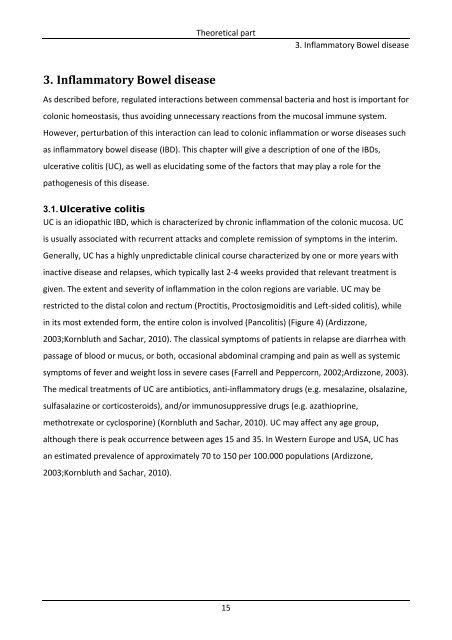Role of Intestinal Microbiota in Ulcerative Colitis
Role of Intestinal Microbiota in Ulcerative Colitis
Role of Intestinal Microbiota in Ulcerative Colitis
You also want an ePaper? Increase the reach of your titles
YUMPU automatically turns print PDFs into web optimized ePapers that Google loves.
3. Inflammatory Bowel disease<br />
Theoretical part<br />
15<br />
3. Inflammatory Bowel disease<br />
As described before, regulated <strong>in</strong>teractions between commensal bacteria and host is important for<br />
colonic homeostasis, thus avoid<strong>in</strong>g unnecessary reactions from the mucosal immune system.<br />
However, perturbation <strong>of</strong> this <strong>in</strong>teraction can lead to colonic <strong>in</strong>flammation or worse diseases such<br />
as <strong>in</strong>flammatory bowel disease (IBD). This chapter will give a description <strong>of</strong> one <strong>of</strong> the IBDs,<br />
ulcerative colitis (UC), as well as elucidat<strong>in</strong>g some <strong>of</strong> the factors that may play a role for the<br />
pathogenesis <strong>of</strong> this disease.<br />
3.1. <strong>Ulcerative</strong> colitis<br />
UC is an idiopathic IBD, which is characterized by chronic <strong>in</strong>flammation <strong>of</strong> the colonic mucosa. UC<br />
is usually associated with recurrent attacks and complete remission <strong>of</strong> symptoms <strong>in</strong> the <strong>in</strong>terim.<br />
Generally, UC has a highly unpredictable cl<strong>in</strong>ical course characterized by one or more years with<br />
<strong>in</strong>active disease and relapses, which typically last 2‐4 weeks provided that relevant treatment is<br />
given. The extent and severity <strong>of</strong> <strong>in</strong>flammation <strong>in</strong> the colon regions are variable. UC may be<br />
restricted to the distal colon and rectum (Proctitis, Proctosigmoiditis and Left‐sided colitis), while<br />
<strong>in</strong> its most extended form, the entire colon is <strong>in</strong>volved (Pancolitis) (Figure 4) (Ardizzone,<br />
2003;Kornbluth and Sachar, 2010). The classical symptoms <strong>of</strong> patients <strong>in</strong> relapse are diarrhea with<br />
passage <strong>of</strong> blood or mucus, or both, occasional abdom<strong>in</strong>al cramp<strong>in</strong>g and pa<strong>in</strong> as well as systemic<br />
symptoms <strong>of</strong> fever and weight loss <strong>in</strong> severe cases (Farrell and Peppercorn, 2002;Ardizzone, 2003).<br />
The medical treatments <strong>of</strong> UC are antibiotics, anti‐<strong>in</strong>flammatory drugs (e.g. mesalaz<strong>in</strong>e, olsalaz<strong>in</strong>e,<br />
sulfasalaz<strong>in</strong>e or corticosteroids), and/or immunosuppressive drugs (e.g. azathiopr<strong>in</strong>e,<br />
methotrexate or cyclospor<strong>in</strong>e) (Kornbluth and Sachar, 2010). UC may affect any age group,<br />
although there is peak occurrence between ages 15 and 35. In Western Europe and USA, UC has<br />
an estimated prevalence <strong>of</strong> approximately 70 to 150 per 100.000 populations (Ardizzone,<br />
2003;Kornbluth and Sachar, 2010).
















